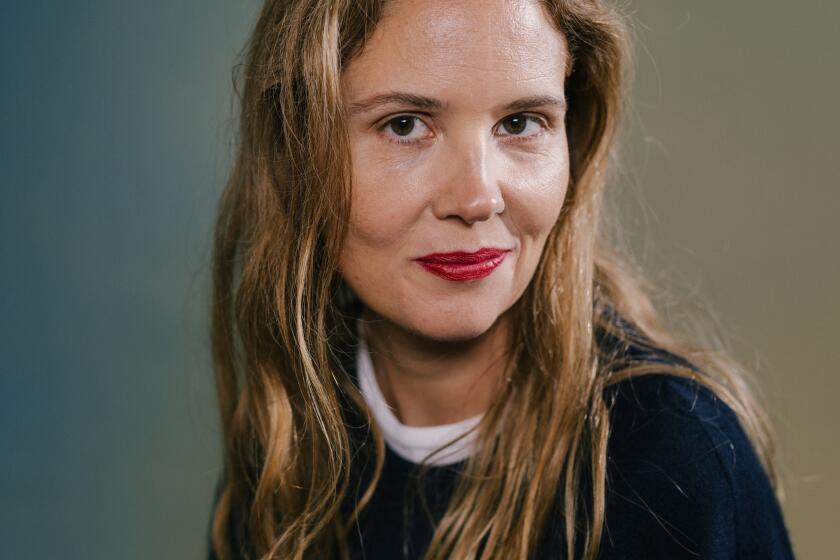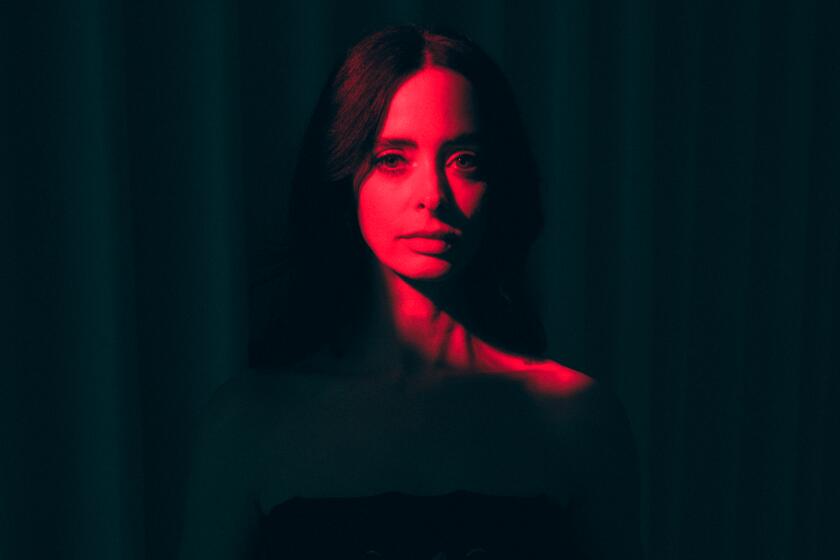How a filmmaker couple’s adoption story inspired the bloody dark comedy ‘I Don’t Understand You’

- Share via
A bloody horror-comedy isn’t the genre that springs to mind as a “love letter” to one’s 5-year-old, but for Brian Crano and David Joseph Craig, it’s the perfect way to express their devotion to their child.
The married filmmakers started penning the semi-autobiographical screenplay as a therapeutic exercise during the COVID-19 pandemic shortly after adopting their son.
“With the tiredness of having a newborn, it was kind of our mutual catharsis during that time,” Craig said.
But a deeply serious, emotional script about their difficult road to fatherhood didn’t interest them. Instead, the final product begins as a lighthearted comedy then turns dark — complete with a few dead bodies.
“I Don’t Understand You,” which hit theaters Friday, stars Nick Kroll and Andrew Rannells as characters loosely based on Crano and Craig, who also co-directed the movie.
The season looks strong, loaded with the kind of big Hollywood swings, smart indie alternatives and a fair amount of delicious-looking dumb, necessary in every summer diet.
The beginning of the story faithfully follows the real-life couple’s journey to become fathers, including a heartbreaking experience with adoption fraud. They had been trying to adopt a child for nearly three years and felt weighed down by the challenges. In a twist of fate, they were matched with a birth mother just as they were traveling to Italy to celebrate their 10th anniversary.
That trip was essentially a comedy of errors. Their car got stuck in a ditch during a relentless rainstorm and the couple was rescued by an old Italian woman and her family, whom they couldn’t understand at all.
When they told their friend — and the movie’s eventual producer — actor and filmmaker Joel Edgerton about the travel nightmare, he encouraged them to get writing.
But how did Crano and Craig go from crafting characters loosely based on themselves to making them (mostly accidental) murderers? By adapting their real-life coping mechanism to the film.
“We processed our own trauma around what happened to us personally through really dark comedy to each other,” Craig said. “It just felt like that was the story we were prepared to tell.”
“Doing a polemical, flag-wavy, tear-jerky adoption movie felt like really the wrong vibe for us,” Crano added.
Palme d’Or-winning director Justine Triet and her co-screenwriter and partner, Arthur Harari, discuss how they hatched “Anatomy of a Fall” during the pandemic.
As the couple described the process of making the film, they frequently finished each other’s sentences. They were in sync despite being on a Zoom call from different coasts, with Craig in New York ahead of the film’s premiere and Crano in L.A. Their overlapping responses seem to mirror their writing process — each is attuned to his partner’s strengths and how his mind works, and they’re both “obsessed” with iteration, as Crano said, hoping to find the perfect turn of phrase or one-liner through repeated conversations.
“Not to interrupt, Brian,” Craig interjected at one point, “but I think this is where you were going.”
Kroll and Rannells’ Dom and Cole, like Crano and Craig, learn the happy news of a match after adoption struggles, get their car stuck in a ditch on their anniversary trip and find refuge in an old Italian woman’s home. Then the plot departs from reality and descends into macabre humor, with Cole accidentally pushing the old lady down the stairs, killing her.
The duo didn’t have much of the plot drawn out ahead of time. Crano said they just wanted to explore the question: “What’s the worst thing that they could do next?”

For Kroll and Rannells, playing characters inspired by their directors enabled them to tap into the emotional heart of the story in an authentic way. Both actors, speaking to The Times via Zoom, said the directors were transparent about their adoption experience.
“It would be so funny if we had been like, ‘Hey, what was it like when you found out that you weren’t gonna get the baby?’ and they were like, ‘How dare you?’” Kroll quipped. “But it was super helpful to have them as references and resources, but also at the same time, their willingness to let us make choices that may not have been exactly what they would have said or how they would have said it. David and Brian had a really clear vision for it, but also were quite open to things organically taking shape that was new to the film.”
Rannells, who was working with a directing team for the first time, commended the duo’s ability to run the ship collaboratively.
“They were very much always on the same page, which was great,” he said. “That was maybe a little bit of a fear of going into it. I was like, ‘How is this really going to work?’ Like, ‘Who are we listening to and how?’ But they did it really seamlessly and it never felt overwhelming.”
Krysten Ritter, whose second novel is out now, loves writing characters who are ‘unpredictable, a little bad, a little wounded.’
Much of the comedy Kroll and Rannells deliver is rooted in cultural misunderstandings. Dom’s Duolingo streak proves insufficient in helping the couple communicate in Italy, and they often mistake the locals’ remarks or actions as homophobic.
Craig said the characters’ frequent misinterpretations took on the role of the “monster,” since this is a horror movie without a true boogeyman. Their ignorance leads them to believe they’re in danger. “Our monster is their own perception of hostility,” he said.
“There’s such a deep desire to be comfortable that they would almost rather do violence than be uncomfortable,” Crano added. Craig chimed in, “And have to talk about it with somebody they can’t communicate with.”
Although they have committed American tourist faux pas like their characters, Crano and Craig said the adoption story is the most true-to-life aspect of the movie.

The couple’s beloved dog Axel — who died just a few months after they wrapped shooting — is Dom and Cole’s pet in the film and their young son, Washington, nicknamed “Washy,” plays Dom and Cole’s child in a brief scene. After seeing himself on the big screen at the film’s debut at South by Southwest last year, Craig said the 5-year-old thinks he’s a movie star.
His one demand, they said, was to wear a cowboy costume for his scene, which they obliged. Crano and Craig said Washy will likely be allowed to watch “I Don’t Understand You” at a younger age than he should. “The thing we really hope he gets out of it is the true message of the movie: ‘What would you do for your child?’” Craig said. “And we hope he really understands that we would do anything for him.”
“It is a love letter to him,” Crano said. “In a purely strange way,” Craig added, finishing his husband’s thoughts once more.
More to Read
Only good movies
Get the Indie Focus newsletter, Mark Olsen's weekly guide to the world of cinema.
You may occasionally receive promotional content from the Los Angeles Times.














